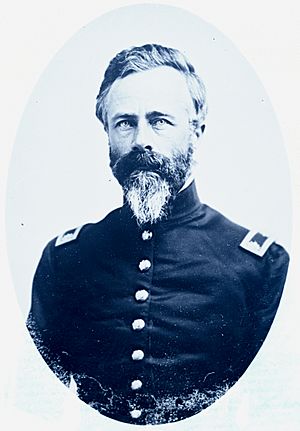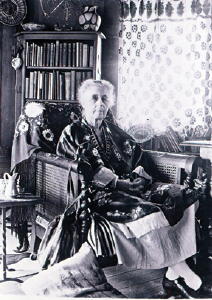Thomas Williams (Union general) facts for kids
Quick facts for kids
Thomas R. Williams
|
|
|---|---|

Civil War General Thomas Williams (1815-1862)
who died in the Battle of Baton Rouge |
|
| Born | January 16, 1815 Albany, New York |
| Died | August 5, 1862 (aged 47) Baton Rouge, Louisiana |
| Place of burial | |
| Allegiance | United States of America Union |
| Service/ |
United States Army Union Army |
| Years of service | 1832, 1837–1862 |
| Rank | |
| Unit | Department of the Gulf |
| Commands held | Williams' Brigade |
| Battles/wars | Black Hawk War Second Seminole War Mexican War American Civil War |
| Other work | career soldier |
Thomas R. Williams (born January 16, 1815 – died August 5, 1862) was an officer in the United States Army. He served as a brigadier general for the Union Army during the Civil War. He was killed while leading Union troops at the Battle of Baton Rouge.
Early Life and Family
Thomas R. Williams was born in 1815 in Albany, New York. His father, General John R. Williams, was a very important person in Michigan. He was the first Mayor of Detroit. Thomas was one of nine children.
His family had lived in Detroit since 1765. Before that, they had settled in Albany, New York, in 1690.
Military Adventures
Thomas Williams started his military journey in 1832. He was a private in an infantry (foot soldiers) company. He served as a trumpeter during the Black Hawk War. His own father was his commander.
The next year, he got to go to the United States Military Academy (West Point). He graduated in 1837. He even taught math there in 1844! He became a second lieutenant.
He later fought in the Seminole Wars as a first Lieutenant. He also served in the Mexican War. For his good service, he was given temporary promotions. He became a temporary captain in 1847. Then he became a temporary major later that same year.

After the Mexican War, Williams became a full captain. He was sent to Mackinac Island, Michigan. There, he met and married Mary Neosho Bailey. Her father was also in the U.S. Army.
Williams was later sent to Florida and the Utah Territory. In the late 1850s, he taught at the Artillery School at Fort Monroe in Virginia.
Civil War and Final Battle
When the Civil War started, Williams was promoted to major in 1861. On September 28, 1861, President Abraham Lincoln made him a Brigadier General.
He was first in charge of a brigade (a large group of soldiers) near the Potomac River. Then he went to North Carolina. Later, he joined Major General Benjamin Butler to take over New Orleans, Louisiana. Williams and his brigade were then sent to occupy Baton Rouge, Louisiana. On May 29, General Williams arrived with about 3,000 soldiers.
During the summer, Williams' soldiers started working on something called Grant's Canal. This was a new channel (a dug-out waterway) across the Mississippi River. The idea was to let gunboats and transport ships go around the Confederate defenses at Vicksburg, Mississippi.
In August 1862, Confederate forces attacked Baton Rouge. They wanted to take back the state's capital. In this fight, known as the Battle of Baton Rouge, General Williams was killed. He was shot in the chest on August 5, 1862. He was leading his troops in defending the city.
Williams' body was on a transport ship called the Whiteman or Lewis Whitman. This ship was carrying other dead and wounded soldiers. It sank in the Mississippi River after hitting a Navy ship. Luckily, Williams' body was found. He was buried in his family's plot in Elmwood Cemetery in Detroit, Michigan.
Family Life
Thomas Williams had two sons, John R. Williams and Gershom Mott Williams. He also had a daughter named Mary Josepha Williams.
Gershom became the first bishop of the Episcopal Diocese of Northern Michigan. He also published his father's personal writings. Josepha became a doctor. Like her mother, Mary Neosho Williams, she owned a lot of land in Colorado. She helped start a medical center and a nursing school in Denver, Colorado.

